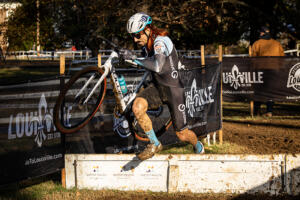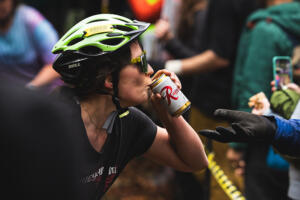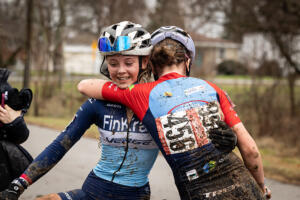Mud, Sweat and Gears
A sport conducted outdoors during fall in the Pacific Northwest can mean only one thing: it will be muddy. Really muddy. And muddy is how cyclocross riders like it.
Origin Story
Cyclocross (CX) is an ultracompetitive and comically unpredictable cycling sport that involves closed-course outdoor races in the fall and winter. While its origins are murky, the most retold version is that in the early years of the 20th century, French army private Daniel Gousseau rode his bike across the ruddy French countryside delivering messages to and from generals. Lore has it that he often had to dismount to conquer the obstacles he encountered on his trips. It was Gousseau who organized the first French CX championship in 1902. In 1910, when Octave Lapize won the Tour de France, he credited off-season CX training for his victory.
 Cyclocross was a European sport throughout the 1920s and ’30s, eventually popping up in Chicago in 1963. Now it’s a worldwide phenom, with many organized races and championships regulated by the Union Cycliste Internationale and sanctioned by USA Cycling.
Cyclocross was a European sport throughout the 1920s and ’30s, eventually popping up in Chicago in 1963. Now it’s a worldwide phenom, with many organized races and championships regulated by the Union Cycliste Internationale and sanctioned by USA Cycling.
The Lay of the Land
CX courses are one and a half to two miles long, closed, and different every time. Races are composed of four to nine laps, which make it a great spectator sport since riders pass you multiple times in a short period. Participants wind their way through myriad terrains—from dirt to concrete and even over lit firepits on occasion. They slog through sand and confront obstacles and roadblocks that require guts and fast action. Riders are just as likely to slip and slide down a steep hill as they are to face sand pits that threaten to slow them down. Racers must navigate wooden barriers as high as 16 inches by either jumping over them while still on their bike (called bunny hopping) or by dismounting and jumping over them on foot. Bunny hopping is a skill many racers strive to master—for the street cred.
The whole tone of CX is audacious yet convivial, respectful yet irreverent, deliciously unrestrained and always intense. Anywhere from a dozen to a couple hundred cyclists participate depending on how popular the sport is in the region (Portland beats Seattle in terms of its popularity). With that much cacophony, a strong mental game is required and staying calm under pressure is key. Racers can be up on and down off their bike as many as 30 times in a race that runs 30–60 minutes.
Despite the competitive aspect of CX, the vibe is supportive and the camaraderie strong. Lighthearted hecklers (also known as spectators) cheer and raucously ring cowbells to urge the riders on. Around Halloween many riders show up in costumes, which makes for quite the spectacle. It’s just a whole lot of fun.
Come As You Are
The overarching message of CX is that all are welcome, from tender young riders to fierce 80-year-olds. And they mean it too—CX has a very low threshold to entry. Anyone can show up and participate in a race no matter their state of physical fitness or racing experience. If you’re interested in CX, there is a performance category that will fit you. All you need is a bike, the ability to use it, a helmet, some eye protection and a lot of moxie.

Fanatics of the sport report that CX is the hardest yet most fun workout there is. Most, but not all, participants have a moderate to high level of physical fitness and anyone can test ride the course before the race to familiarize themselves with the gauntlet to come. There are free skills clinics at Marymoor Park every Tuesday evening at 6 p.m. through September 16, courtesy of a CX organization called Lemon Peel, to help you bunny hop over the learning curve.
The Finish Line
A CX race is an exhilarating, dirty and super-fun experience. You will most likely be wet, cold and tired at the end, but you’ll also be grinning ear to ear and leaving with some new like-minded friends.
The Bike
To be clear, you don’t need a special style of bike for CX. Some people show up on mountain bikes and others on gravel bikes. However, a specific CX bike (CXB) has evolved over the years to accommodate the beating they take on the course.
• Originating from a road bike, CXBs have a slightly different frame anatomy and are lightweight yet stiff and responsive, usually made of aluminum or carbon fiber.
• Their frames are wider and house narrow, knobby tires, meant to handle what the course throws at them: copious amounts of mud.
• Tires are generally at a lower pressure to increase traction. Because, mud.
 • The gears are also kept lower to account for the hills and mud.
• The gears are also kept lower to account for the hills and mud.
• Participants often run with their bikes hiked up over their shoulders, so top tubes are shaped for easier shouldering, with flattened undersides for comfort. That doesn’t mean you won’t get a wicked bruise there. But again: street cred.
• Bottom brackets are higher to avoid drag (from the mud) and for obstacle clearance.
• Disc brakes are almost exclusively used for more control in the mud.
Cyclocross Resources
CXR | cross-revolution.com
Lemon Peel | lemonpeelproductions.com
MFG Cyclocross | mfgcyclocross.bike
WA Cyclocross | wacyclocross.org









